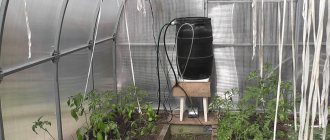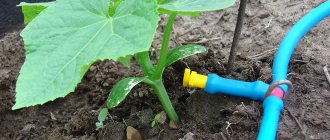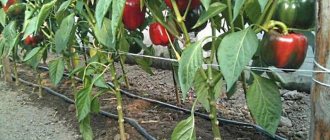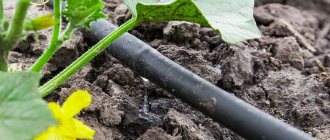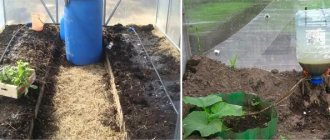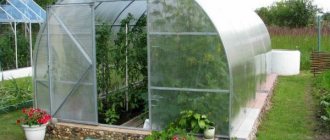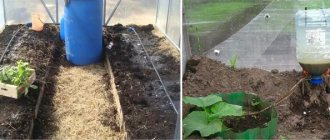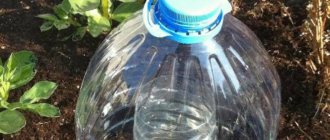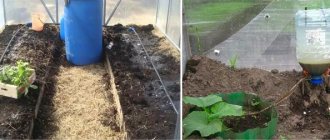When talking about irrigation systems, most people think of standard garden sprinklers because they are the most well-known option for an automated watering system.
But few people know that in fact there are other, more effective methods that greenhouse farmers have long used to achieve better results and increase productivity. These methods include “Zhuk” drip irrigation. But what kind of system is this, what makes it unique? Our experts have prepared answers to all your questions.
System design
The Zhuk irrigation system is a smart, rational solution for distributing water to each plant.
Drip systems use flexible tubing connected to individual drippers or emitters.
The emitters are located in the root zone of the plant and provide a certain amount of water each time the system is operated.
The “Beetle” system got its name for a reason: the design of its droppers is similar to the shape of a beetle’s legs: additional tubes diverge from the main tubes in pairs, which supply moisture to the root zone.
This is the most effective, as well as convenient and inexpensive method of watering.
With the help of automation, you can set the time, quantity, and watering points, which allows you not only to ensure uniform irrigation, but also to eliminate overflow and control this process throughout the day, which becomes especially important in large greenhouses where fastidious plants that need water are grown. under ideal conditions and frequent irrigation.
Recommendations for use
Drip irrigation Beetle will last for many years if used correctly.
Irrigation filter Zhuk
- In autumn, the drip irrigation system is removed from the site. The water is drained and fully assembled, all parts are brought into the heat (can be in the basement, attic or in the house).
- It is better to store the Zhuk system at a temperature of +3 degrees.
- In order not to redo the system every year, it is recommended to plant plants annually according to the same scheme.
- If water stops flowing, you need to check the serviceability of the system; for example, the filter may simply be clogged.
- If water does not flow under a particular plant, then the reason is a clogged drip. You need to remove it and clean it. The tee may also become dirty, in which case it is also important to disconnect and clean it.
Kinds
Despite the simplicity of the design, the Beetle is divided into the following types:
- Greenhouse, used for watering a small number of plants (up to 30 bushes).
- Greenhouse, becoming indispensable in greenhouses. One system is capable of controlling watering of up to 60 bushes.
- Automated and non-automated.
Depending on the purpose, a system is selected, and, of course, the automated option is the most rational, profitable and convenient.
Principle of operation
The essence of the system’s functioning is quite simple: the “Bug” is connected to the water supply, and droppers are installed in the root zone of each plant that needs regular watering.
Next, the time and volume of irrigation are set on the timer.
That's all: then the automation will handle everything; you just need to check the condition of the droppers from time to time and monitor the process of plant growth.
“Bug” is ideal for watering radishes, carrots, peas, decorative flowers - roses, azaleas, petunias, as well as for irrigating alpine hills and lawns.
The main feature of the “Beetle” that distinguishes this system from its analogues is the presence of a fitting, through which the tank is fixed to the system. Moreover, the process of collecting water into the tank occurs automatically.
It is not difficult to adjust the irrigation timing. It can last from one minute to two hours, and the interval varies from one hour to a week. If desired, you can increase the wiring of the system by purchasing additional lines that are quickly attached to those already installed.
When is a drip system needed?
Drip irrigation systems are the best choice for watering greenhouses, greenhouses, and landscaped areas with trees, shrubs and perennials because they give perfect control over how much water each plant receives.
You can choose drippers that provide a lot of water to your plants, or ones that only supply a small amount. There are also mini sprinklers for drip systems that can water areas of the landscape with annual flowers, vegetable seedlings and other plants that need regular watering at long intervals.
Because you can mix and match the drippers you use, the system is customized to suit the needs of your landscape.
Disadvantages of conventional watering
Drip irrigation for the Zhuk greenhouse is a godsend for gardeners. Everyone knows that when watering plants in a greenhouse with a watering can, we wet only the top layer of soil; it is hot in the greenhouse, and the water evaporates quickly, and the leaves of plants often get sunburned from the drops shining on them. Watering with a hose or spinner creates even more problems. The plants are well watered, but there is a real swamp around, very high humidity. Mold and dangerous fungal diseases often grow and the shoots suffer from them. The yield decreases, and sometimes the plants even die. In addition, not all summer residents can be at the dacha all summer and regularly water the plot. During a week in the heat, the plants dry out, and then on the weekend they try to cast them. As a result, they are in a constant state of stress.
Therefore, even a good greenhouse does not guarantee a rich harvest. And all the efforts and expenses for it often bring disappointment to the summer resident. With irregular and shallow watering, a hard crust forms on the soil, making it difficult for plants to breathe. The crops suffer, but the weeds grow well. In addition, if you plant secondary plants - lettuce, parsley or dill - between the tomatoes and peppers, then with normal watering they will be dirty. During drip irrigation, the seals are clean.
Why not a sprinkler system?
Sprinkler systems are most often used for watering lawns and low ground cover plants because these types of plantings require water to be evenly distributed throughout the entire area. However, sprinkler systems are less useful for beds with mixed plantings of shrubs and flowers for a number of reasons.
The stream of water from the sprinkler system runs into the tall garden plants, preventing the spray from reaching the rest of the area and knocking flowering perennials to the ground.
Additionally, plants with wet foliage are more susceptible to fungal and bacterial diseases, so using drip irrigation to deliver water directly to the roots will help promote a healthier garden.
Drip systems are also the best choice for those who want to save water.
Sprinkler systems release large amounts of water into the air in a short period of time.
This can result in water being wasted through runoff, evaporation, and overwatering areas of the landscape that could be significantly less.
Whenever you spray water into the air for irrigation, you are wasting 50-70% of it, depending on weather conditions. A drip system, on the other hand, releases a controlled amount of water very slowly at the desired location. This allows for more gentle watering of newly planted plants, as well as moisture-sensitive plants.
Finally, because drip systems only water the plantings and not the spaces between them, you'll have fewer weeds in your landscape, which is also a huge plus.
Who wants to spend all day long getting rid of weeds? It is unlikely that anyone will answer this question positively. A drip system reduces maintenance costs in your landscape, saving you time and effort.
Expert opinion
Torsunov Pavel Maksimovich
If you have a lot of wildlife or pests in your landscape, sprinklers can sometimes be a better option, even for garden beds. Rodents and other animals will chew through drippers to get to an easy water source.
Price
Drip irrigation prices vary depending on the size of the area, the number of plants requiring drips and other factors specific to your garden.
But on average, professional installation of a single-zone drip irrigation system usually costs about 1,600-2,000 rubles.
However, it is worth considering that each drip zone can be configured separately.
For a small area with few plants, adding an additional drip zone can sometimes cost as little as RUB 470.
Expansion kit for the Beetle
The expansion kit is included in the Zhuk drip irrigation system. It is necessary for those who want to provide moisture to a larger number of plants. Using one expansion kit, you can increase watering by 20 plants. If you need to irrigate a very large area, you can purchase as many expansion kits as needed. And of course, you can buy an additional main hose 20 meters long. An expansion kit for a tank costs approximately 500 rubles, and for a water supply - 600 rubles. An additional hose can be purchased for 500 rubles. Again, please note that these are approximate prices only; If you contact the manufacturer, you can order it much cheaper.
Using the root system for lawns
Experts recommend using root drippers for all plants, including lawns. Thus, US greenhouse specialists use specially designed types of irrigation tubes that have technology to prevent clogging of drippers with roots and soil.
That's why even golf courses in America are irrigated this way to save water and provide better watering, which is not possible to achieve using standard types of expensive sprinkler systems.
Another benefit of using root drip irrigation on lawns is that you can effectively irrigate any shape of lawn, even tight curves, without over-spraying.
In addition, you can avoid unsightly installation of sprinklers that detract from the overall design by hiding the drippers under the ground.
DIY drip irrigation device in a greenhouse and professional equipment
The auto-drip irrigation system, no matter how complex it is, greatly facilitates the work of a person maintaining plants in a greenhouse. Conventional watering, as well as semi-automatic watering, takes almost half the time for servicing the greenhouse. If you decide to equip your auto-drip irrigation system, then your efforts will not be in vain and labor costs for watering plants will be minimized.
Installing drip irrigation in a greenhouse with your own hands is a way out of a situation where you become a hostage to caring for your plants around the clock. A self-made or purchased irrigation system will become your reliable assistant in maintaining the greenhouse.
If, even after watching the video tutorial, you do not risk taking on making the system yourself, then you can buy a ready-made watering kit in the store. There you will be offered a large number of auto-drip irrigation systems of varying complexity to choose from.
You can build a drip irrigation device in a greenhouse with your own hands
Well-known auto-drip irrigation systems:
- Leroy Merlin;
- Akvadusya;
- Water strider;
- Gardena;
- Bug;
- Arduino;
- Signor Tomato.
The best of all the above is the Gardena irrigation system.
If your health and time are important to you, then consider installing an auto-drip irrigation system in your greenhouse. By investing a lump sum, you can use this system for a long time. The technology allows the droplet system to be used repeatedly. Installation and installation of this equipment is not difficult. This system works both in a greenhouse and in open ground. It can be used to water any plants, including roses, where watering is generally very difficult.
Planning and installation
The design of your drip system will be based on the type of soil and plants you have. In clay soil, the water spreads out from the drip emitter and covers a wider area, while in sandy soil the water from the drip emitters goes almost straight down. This may affect the variety and placement of IVs.
Plant sizes and varieties will also be taken into account when designing the system.
Large plants such as trees may need two, three or more emitters spaced evenly around the root ball, while perennial flowers may only need one emitter.
Your landscape contractor can guide the process and make sure each plant gets the water it needs.
What crops are you selecting the system to irrigate?
GreenhouseLawn
The installation process is very simple. After planting the plants, a drip irrigation system is installed, tubes and emitters are connected.
The next step is to secure the tube to the soil surface using landscape stakes or pins, then add wood mulch.
This is done to hide the irrigation pipe so it is not visible in the finished landscape. If you are using landscape fabric, lay it down after planting but before installing your drip irrigation system.
Expert opinion
Kurdin Sergey Sergeevich
Unless the system is equipped with anti-clogging technology, never install drippers deep underground. Small roots can grow into emitters and clog them. Also, do not cover the tube with landscape fabric or weed mats because this makes it difficult to diagnose problems with the drip system or update it when adding new plants.
If you have an existing sprinkler system, you may be tempted to tie your drip system directly to your sprinkler pipes in order to cut costs. However, the pros say that this is a big mistake.
Since a sprinkler system throws out a large amount of water in a short period of time, running a drip system on the exact same line will either result in your drip system not being able to handle its irrigation task or your sprinkler system will be over-watered.
In addition, dripping from sprinkler pipes prevents the use of a mineral filter in the water supply. This may cause the emitters to become clogged and stop working. It is always best to have sprinklers and drip systems in separate areas.
Installation principles
In order for a drip irrigation system for a greenhouse or open area to be installed correctly, you need to perform a calculation. It is necessary to determine the volume of water consumption. Then the number of irrigation pipes on the site is calculated, taking into account planting patterns. The site is divided into blocks for irrigation. Then you need to select filter stations, select the main pipeline and distribution pipes. With the right calculations, the system works effectively.
It is better to entrust the assembly to specialists. But you can do everything yourself. The kit contains instructions, after studying which the work can be performed by a person who has no experience in this field. If you are installing the system yourself, you should determine whether it will be cold or warm watering. This will determine whether the container needs to be heated or not. As reviews show, many summer residents choose this particular method of watering, and besides, you can install it yourself if you follow the instructions.
What components does it consist of?
The Zhuk drip irrigation system has several parts, but you won’t get confused in it after installation:
- Y-filter. Municipal water supplies are filled with small particles of sand, minerals, rust, and debris. While we may not notice it in our faucets, drip emitters can become clogged with this sediment and stop functioning. The Y-filter is a simple filter that keeps the emitters clean.
- Pressure regulator. Drip systems require less water pressure than sprinkler systems. In fact, too much water pressure can blow the emitters off the pipes and cause ruptures. A regulator should be used to reduce the water pressure in the drip system.
- Valve. The valve receives electrical signals from a timer that control the process of turning the water on and off. Each zone will use a different valve, and the valves are usually placed in a green plastic box somewhere in the landscape.
- Pipeline. Half-inch polyethylene tubing is used to distribute water throughout the landscape, while quarter-inch tubing is used to distribute water from the main half-inch line to individual plants.
- The quarter-inch connector establishes a secure, leak-proof connection between the half-inch tube and the quarter-inch tube.
- Drip irrigation emitters, or emitters, come in a variety of styles, but they all release a specific amount of water. You can adjust the intensity and frequency of watering based on the characteristics of the plant, terrain, soil, and weather conditions.
A professionally installed Beetle drip system is an effective and relatively inexpensive way to save water and enjoy your landscape with low maintenance.
The Beetle can share a timer with your sprinkler system, and the water sensor makes your system fully automatic. It senses weather changes and regulates the watering cycle. Using a Beetle irrigation system is a great way to save both time and water, giving every plant the perfect, timely watering.
Advantages
What are the main advantages of using the Zhuk drip irrigation system? There are a lot of them. Let's try to highlight the main ones.
- The system is equipped with a filter that automatically purifies the water. It will prevent hoses and drippers from becoming clogged with debris.
- Installation of the main and supply hoses is carried out using an awl, which has a limiter - this means that it will not be possible to pierce the hose through and ruin it.
- The water level in the barrel from which the Zhuk pumps water can be easily monitored using a level hose.
- “Beetle” doses water to the roots of plants, so watering occurs gradually and is as beneficial as possible for the crops. By the way, water also does not compact the soil.
- Plant productivity due to the use of drip irrigation increases by 40-70%.
- The system can be expanded unlimitedly.
- The price of "Zhuk" is affordable and pleasant in comparison with other irrigation systems.
- The system allows you to regulate the frequency and intensity of irrigation.
Drip allows you to adjust the frequency and intensity of irrigation
- Thanks to the drip irrigation system, water consumption in the garden is significantly reduced.
- The device comes with a fitting that easily allows you to connect the “Zhuk” system to any container - almost no other irrigation system has such an element.
- The hoses through which water flows in the Zhuk are made of black polyethylene, due to which the water in them does not bloom.
- The system’s droppers are made in the shape of a sinusoid, which means they cannot become clogged.
- The tees included in the package prevent hose kinks if it is turned at a right angle.
- Taps and plugs allow you to install the Beetle on several beds or greenhouses at once. It is not necessary that all beds be watered at the same time.
- Finally, you simply eliminate the need to lug around heavy buckets and thick rubber hoses if you purchase a drip irrigation system.
Drip irrigation "Bug" from a water supply
Prices for the Zhuk drip irrigation system
drip irrigation system Zhuk
Questions and answers
How is a drip irrigation system different from conventional sprinklers?
Sprayers disperse large volumes of water, while some plants receive excess moisture, while it simply does not reach others. The drip system involves connecting special tubes to each plant.
Is it possible to install drippers deep underground to hide them?
This is not recommended at all, as sprouted roots can clog the tubes and damage them. Drippers can be installed under the ground only in cases where the system is equipped with a clogging prevention function.
Can the drip system be used for lawns or only for greenhouses?
The drip system is universal. It is equally suitable for watering fruit plants, flowers, and lawns.
Can I cover the irrigation pipe with landscaping fabric?
It is highly not recommended as it may disrupt the functioning of the system.
Is it possible to connect a spray system with a drip system?
No. Such an attempt to save money will disrupt the functioning of both systems. On the one hand, drip irrigation will be insufficient, while the spray system will also begin to malfunction.
"Signor Tomato"
Produced by Krovstroy LLC.
There are three types of kits on sale with a minimum configuration: they include an emitter strip with a distance between emitters of 30 cm and the necessary fittings for connection. The manufacturer also offers ready-made kits based on a drip tube and external droppers with and without a timer. The kit includes special splitters that help organize watering as conveniently as possible. Drip irrigation system "Signor Tomato"
The drip irrigation system from Signora Tomato allows you to organize automatic control of irrigation on the site. The most expensive set includes a controller. The control unit is completely autonomous, as it is powered by the included solar battery. To install the system, there is no need to lift the container and insert a tap into it - the kit includes a submersible pump that is lowered into the barrel and provides water supply.
Drip irrigation "Signor Tomato" with solar battery
| Included | 24 meters | 50 meters | 100 meters | Signor tomato 60 | Signor-tomato machine |
| Emitter drip tape | 24 | 50 | 100 | ||
| Drip tube | 18 m | 18 m | |||
| Microtube | 12 m | 17 m | |||
| Splitters | 30 | 30 | |||
| Droppers | 60 | 60 | |||
| Fitting | + | + | + | + | + |
| Timer | + / — | ||||
| Controller | + | ||||
| Solar battery | + | ||||
| Pump | + | ||||
| Watering from a container | + | + | + | + | + |
| Price | 750 | 1150 | 1150 | 2900/1400 | 5200 |


